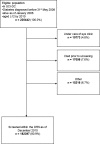Rates of referable eye disease in the Scottish National Diabetic Retinopathy Screening Programme
- PMID: 24599419
- PMCID: PMC4033179
- DOI: 10.1136/bjophthalmol-2013-303948
Rates of referable eye disease in the Scottish National Diabetic Retinopathy Screening Programme
Abstract
Aims: Diabetic retinopathy screening aims to detect people at risk of visual loss due to proliferative diabetic retinopathy, but also refers cases of suspected macular oedema (maculopathy). At the introduction of screening, ophthalmology was concerned that referral rates would be unmanageable. We report yield of referable disease by referral reason for the first 5 years of the programme.
Methods: We extracted screening results from a nationwide clinical diabetes database to calculate annual referral rates to ophthalmic clinics. We used logistic regression to examine associations between clinical measures and referable disease.
Results: 182 397 people underwent ≥ 1successful retinal screening between 2006 and 2010. The yield of referable eye disease was highest in the first 2 years of screening (7.0% and 6.0%) before stabilising at ∼4.3%. The majority of referrals are due to maculopathy with 73% of referrals in 2010 based on a finding of maculopathy.
Conclusions: The commonest cause for referral is for suspected macular oedema (maculopathy). Referral rates for retinopathy have stabilised, as predicted, at relatively low rates. However, ophthalmology workload continues to rise as new treatment options (ie, monthly intraocular injections) have unexpectedly increased the impact on ophthalmology. A review of the screening referral path for maculopathy may be timely.
Keywords: Epidemiology; Macula; Retina.
Published by the BMJ Publishing Group Limited. For permission to use (where not already granted under a licence) please go to http://group.bmj.com/group/rights-licensing/permissions.
Figures
References
-
- Scottish Diabetic Retinopathy Grading Scheme 2007; Scottish Diabetic Retinal Screening Collaborative. 2007 [cited 2013 November 22nd 2013]. http://www.ndrs.scot.nhs.uk/ClinGrp/Docs/Grading%20Scheme%202007%20v1.1.pdf.
-
- Pandit RJ, Taylor R. Quality assurance in screening for sight-threatening diabetic retinopathy. Diabet Med 2002;19:285–91 - PubMed
Publication types
MeSH terms
Grants and funding
LinkOut - more resources
Full Text Sources
Other Literature Sources
Medical

